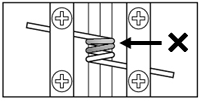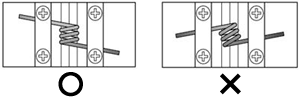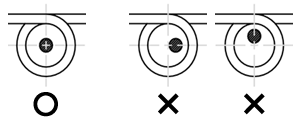FAQ about PC-10 / PP-830
When you assume to find a possible problem as the function of PC-10, and can not solve the problem, the information in this chapter might be useful. Frequently asked questions are summarized in categories that you can refer to. In the event of troubleshooting except the troubleshooting with error messages, consult the following pages in each category. If the trouble persists after referring to solutions in those pages, contact the nearest Narishige office. Please do not attempt to make repairs on this instrument by yourself.
- Related to Power Supply
- Related to the Heater Unit
- Related to the Pipette Pulled
- Related to the Slider Unit
- Related to the Error Messages
CAUTION!
 |
Never touch the Heater Unit. Even when the heater looks not heated, the residual heat will remain to maintain reproducibility while the power is on. Before this procedure, switch the power off, and disconnect the AC power cord. Wait from 5 to 10 minutes, and make sure that the whole heated unit cools down completely. Never turn the power on until this procedure becomes completed. |
Related to Power Supply
| Problems | Probable Causes | Remedies |
|---|---|---|
| Even if the power is on, "HEATER LEVEL" does not display anything to illuminate. | AC Power Cord is disconnected. | Plug the AC Power Cord firmly in the receptacle. |
| The voltage setting inside the AC Power Inlet does not agree to the working voltage. | Make a correct voltage setting conforming to the working voltage. | |
| Fuses housed in the AC Power Inlet are blown. | Re-check the fuse condition to confirm two things that fuse is not blown, and a correct fuse is used according to the matching working voltage. | |
| After the power switch turns on, the fuse is blown right after the moment. | Internal Controlling Board has malfunctioned possibly. | When non-standard Heating Element is applied to the instrument, or Heater values are set excessively too high, it causes to break down the internal controlling board. Repairing service is required. |
Related to the Heater Unit
| Problems | Probable Causes | Remedies |
|---|---|---|
| What are three digits on HEATER LEVEL supposed to be read? | - | HEATER LEVEL displays the current voltage rate calculated from the maximum voltage, 2.5V, as of 100 percent. The number displayed is NOT the temperature or practical heating power of the Heater Unit. |
| How can I control the Heater value with an increment of 0.1? | - | With the encoding system, the last digit of Heater value is calculated from the voltage that has provided on time. Consequently, calculated number does not always round up to the increment of 0.1. |
| The Heater value kept the same value, but the pipette made was different from usual one. | The Heating Element is deteriorated. | Increase the Heater value to compensate for the loss of heater generation. |
| There is a contamination on the contact between the Heater Block and the Mounting Plates. | If you find a contamination on two Mounting Plates and the contacting surface of Heater Block, polish them with sandpaper that recovers the conduction of electricity. | |
| The coils of Heating Element are touched each other possibly. |
Heating Element will not fully function if some coils are touched together.
As shown the illustration above, if the coils of Heating Element are touched each other, use a wrench to make it separated, or replace it with a new unit of PC-10H. |
|
| The Heating function is inconsistent, and does not work efficiently. |
The Heater Unit is widely affected by the wind of air conditioner, and the heating function gets inconsistent. In addition, the room temperature and humidity may affect the heating function. Please place the instrument to avoid those factors as much as you can. |
Related to the Pipette Pulled
| Problems | Probable Causes | Remedies |
|---|---|---|
| The pipette was pulled, but it looked distorted and off-centered. | A glass capillary has not been placed right at the center of the Heating Element. |
Be sure to install the Heating Element aligned to the Heater Block, not to be installed diagonally.
|
|
Loosen four screws to move the Heating Element to-and-fro, and then fasten the fixing screws of the respective terminals tightly at a position where the center of the element coincides with the center of the heater.
|
||
| When a glass capillary is pulled, it does not break up or not separated. | There are two causes for this possibly. One is the Heater value is too high. Another is the weight is too light. | If the heat value is too high, the amount of melting glass will be increased, thus it can not be pulled completely within the working distance of moving slider. Also, if the weight is too light, the amount of melting glass is increased by the weak tension of light weight(s), therefore it can not be broken up by the slider. Increase the number of weights, or decrease the heater level. |
| Is there any difference in shape between the upper and the lower side of pipettes? | - |
In some settings, two pipettes made by the PC-10 will be almost the same shape between the upper and the lower one, however, mostly those two pipettes will be shaped differently. One reason is the upper pipette stays inside of heater coil, thus it is affected by the remaining heat after the end of pulling procedure. Another is that the upper part of glass capillary is fixed and remained in the same place, and the lower part is pulled downside, therefore the shape of upper pipette and the lower one will be different. Especially, if you perform Two-Stage pull with a long distance set, the two pipettes have completely different shapes. |
Related to the Slider Unit
| Problems | Probable Causes | Remedies |
|---|---|---|
| How should I clean or remove the glass particles out of the Slider Unit? | If broken glass particles or tiny solid objects slot into the rails of the Slider Unit, they will cause the malfunction of the unit. | Use a brush or tweezers to take all of them off. |
| The Moving Slider does not move up to the upper limit, or does not move up smoothly. | The mechanism of Slider Unit has been deteriorated. | If it is hard to make a pipette that you aim, contact a Narishige representative whether a repairing work must be needed or not. |
Copyright © NARISHIGE Group. All Rights Reserved. 1999-2025


